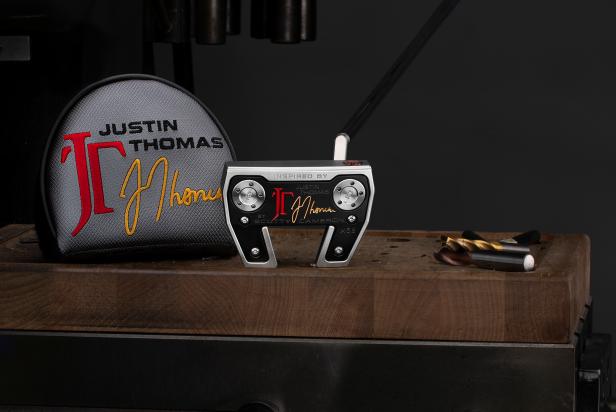Products You May Like
In the summer of 2016 Justin Thomas was frustrated with his putting and went to Scotty Cameron’s putting studio seeking a solution. The result was a prototype Futura X5 putter with a welded neck that allowed the larger head to behave more like the blade Thomas had been using. That design now goes from the prototype stage to a limited-edition offering as the Scotty Cameron Inspired by Justin Thomas Phantom X5.5.
Cameron explained to Golf Digest the genesis of the putter. “He came in and was having some trouble with alignment,” said Cameron. “He wanted something bigger and we had the Futura X5 in the line. He liked the look of the head but the bend on the putter was high and was close to being face balanced and he was used to the Newport 2 that had a quarter toe hang. I went over to the workshop and cut off the neck and created a new neck. He wanted the offset and the swing of the Newport 2, but with a larger, more stable head with more alignment lines. It took about 30 or 40 minutes. It wasn’t very pretty at the time, but when we got back on the camera afterward, we saw the welded neck made it swing like the Newport 2. He also like the lower-profile face. It just kind of clicked with him and it’s been in his bag pretty much since.”
The putter brings with it all the technological hallmarks of Thomas’ putter, including the high moment of inertia mallet head with wings and welded neck. The multimaterial head boasts a solid 303 stainless steel face that extends through the wings, with a 6061 aircraft aluminum sole plate that helps increase stability. The putter is 34.5 inches with 10-gram customizable stainless-steel heel and toe weights. A bead-blast finish reduces glare and Cameron’s signature three red dot pattern has been included in the back cavity as is a new Pistolero grip in cement gray with black lettering.
Cameron’s collaboration with Thomas on the putter was substantial, albeit remote given COVID restrictions. “I would normally hop on a plane and go see him at him at his house, club or on tour,” said Cameron. “But now we had to communicate remotely on screen. I had a couple of people in my graphics department come with a couple of concepts of what we wanted it to look like, down to the headcovers and shaft bands. We’d get the options up on the screen and ask Justin, “OK, which one do you like, A, B or C” and we would do that from various angles and for various traits of the putter. He was so easy to work with because he knew what he liked.”
One of the things he liked was the idea of having the Circle T on the putter—something Cameron normally reserves for tour-only products. That led to a bit of a compromise. “He said he wanted to put the Circle T on the putter and I didn’t say no at first, even though we don’t put that on production models,” said Cameron. “But I wanted to make him happy. The logo for his foundation is a JT and the thought was to put half circles around it to have a pseudo Circle T logo. We gave him three options and he picked the one that is on the putter and it look fantastic.”
For those wondering, yes, all of the 2,020 putters will have the neck welded by hand. “That’s why the price is a little elevated [$850, available Sept. 22] and limited in number. According to Cameron, the neck is created from a block of steel then all the angles are checked. Then the head is dropped into a keyhole and the bottom heel weight is removed before it is welded from underneath. Then on top the neck is welded at the topline area, so it’s two welds and each done by hand.
All the work, however, is worth it, Cameron said. “It’s gratifying to see something that was a prototype that was quite a unique design become popular,” he said. “This putter was very original. It’s what makes it special. It’s a one-off idea that’s now a product I’m very proud to bring to market.


